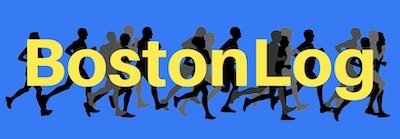In 1982, I was 25 years old. I qualified for The Boston Marathon at the Dallas White Rock Marathon in December of 1981, with a time of 3:05. (I had run one marathon before White Rock, the New Orleans Marathon, also in 1981.) When I received my results booklet after Dallas (these printed results came via snail mail, weeks after the race), I noticed the Boston Marathon qualifying times for each age group were printed on one of the front pages. I was quite a surprised to flip over to my result and see I had qualified for Boston! I honestly was so young, so naïve, I don’t think I even realized the significance of my accomplishment. When I began to tell people about it, it became apparent not many women qualified and ran in the Boston Marathon. Although I had been winning my age group in many local races in the Dallas area for the couple of years I had been running, I did not realize how my time compared to other women worldwide. I was humbled, and I had to plan a trip.
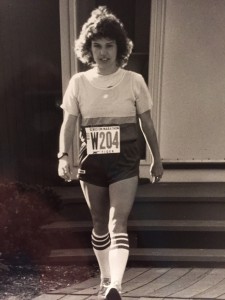
Since my mother’s longtime boss, R.S. Landauer, had recently merged his company and moved to Boston, she arranged for me to stay with he and his wife while we were in Boston. I was engaged to be married, and my fiancé Paul went with me for the trip. I was working at the time for LTV Corporation, and they wanted to do an article about my race for their newsletter. So they sent a photographer to the Landauer’s home and snapped some pictures of me getting ready to leave their house that morning. The photographer also met me at the packet pickup to snap a picture of me getting my bib number.
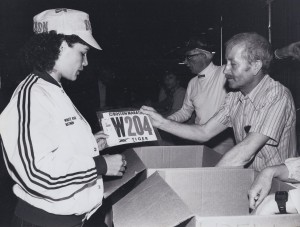
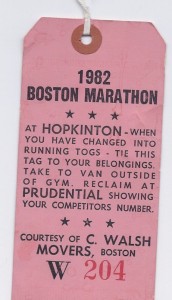
We went downtown the day before the race and picked up my bib number and packet: No expo that I remember, just a lot of excited runners milling around. We were pleased to receive our numbers, a hang tag for our drop bag, our T-shirt and our painters cap. My T-shirt is now the center of beautiful quilt made from my race shirts, and I’ve still got that painters cap.
On race morning, Mr. Landauer drove me to the start of the race at Hopkinton, and my fiancé Paul drove our rental car downtown to the finish area. We had discussed with the Landauers some places where he might stand at the finish line area, and he and I had a place we were to meet afterwards.
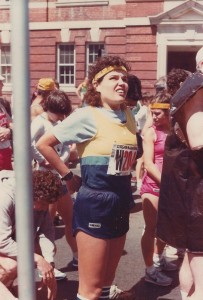
I remember the emotions of the event hit me at the moment when Mr. Landauer had to move over to the sidelines, and I lined up on the street with the other competitors. (I don’t remember any corrals or waves back then, we just placed ourselves about where we thought we should be and hoped for the best.)
Other runners who had experienced Boston had been recommending I shouldn’t worry about my time, but instead drink in each and every moment for my memory. Although that sounded like sage advice, I was way too young to really understand its importance, let alone to have the self-discipline to make myself do it. When the gun went off and the crowd of runners began the jog to the starting line, I was anxious to get going. So I wasted a lot of energy right there at the beginning, weaving in and out, going around slower runners, jumping over curbs and around mailboxes to get to a pace that felt like mine. The weather was quite warm, and extremely humid. I lived and trained in Texas, so I had an advantage over many others who would falter that day.
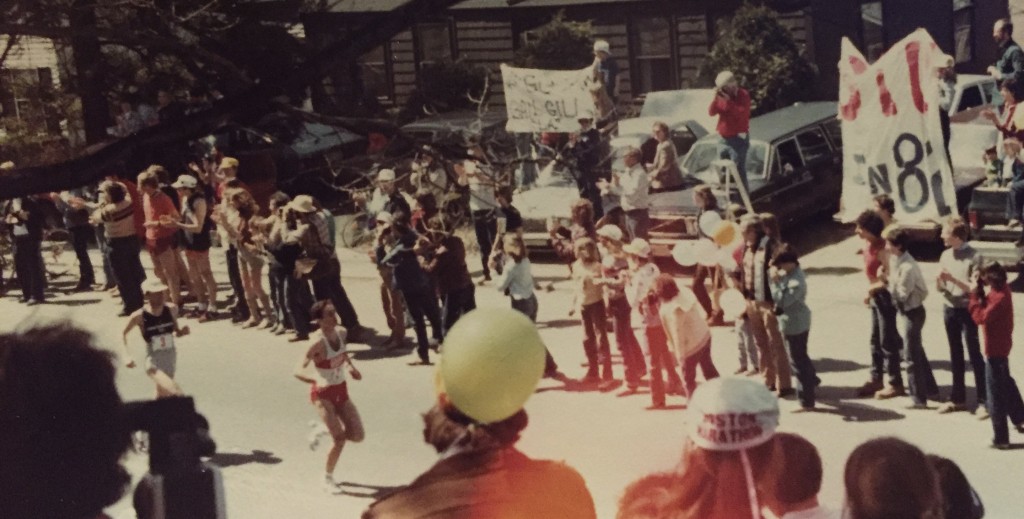
My memories from during the race are few, up until somewhere around Mile 15 or 16. I do remember the girls at Wellesley: they were excited to see a girl, and going through there was really uplifting to my spirits. I don’t remember much about other runners either, I was too focused on my own times and pace. I had the splits I would shoot for written down on the inside of my arm and I was hitting them, so that gave me great incentive to keep up the pace. At around 15 miles, I began to feel it would be necessary for me to find a bathroom. At every water stop I would look for the port-o-johns, but never saw any. By Mile 16, the situation was becoming dire. Finally, I simply stopped and asked a lady who was standing on the side watching the race if she knew where the bathrooms were located along the course. She said, “Well, no, not really, but I live right there. Just go straight up the stairs to the right.” So off I went, relieved both figuratively and literally. When I came bounding back out her door and back on to the course, several from the sides yelled “Hey Rosie, not again.” Ha Ha. (If you don’t know the story from the 1980 race, google “Rosie Ruiz.”) I’m glad an official didn’t have to stop me to make sure my name was not Rosie!
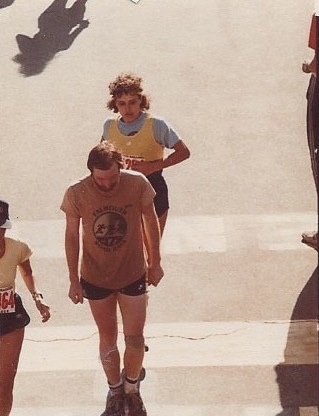
Although I felt much better and was able to keep up my blistering pace for about five more miles, it didn’t make up for my stopping, and the temperature was warming up rapidly on the course. So the time I was shooting for began to dissolve, and I quit looking at my splits. Sweat was pouring off everyone and other runners were seizing up all along the course with muscle cramps that rendered them paralyzed. My legs felt like if I were to go one fraction of a second faster, they too would revolt. So I had to slow down and simply pray I would make it. And I did make it, somewhere around 3:40. As I rounded the corner to head down Boylston Street for the finish, I couldn’t even take in the majesty of the moment. I thought I would collapse if I did anything other than look at my feet, and will them to take each next step. I had never been so glad a race was over. There were no medals back then – except for age group winners. Official times were not recorded after 3:30. I was used to being on the podium for the age groups, but for this race of course I was not. I almost crawled through the finish area. Everyone had to go through a parking garage that was the medical area. There were cots and people with IV fluids everywhere, hundreds of them. I would later read about Alberto Salazar’s spectacular finish. I was glad to be upright and very glad to see Paul. He had been behind the finish line on top of a concrete wall, so he was able to take some good pictures of the finish chutes where runners walked between yellow ropes, single file.
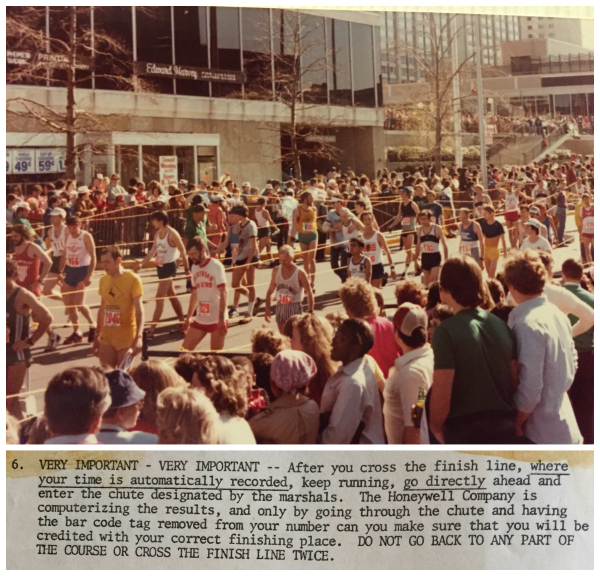
My Mother and I discussed winner Alberto Salazar’s health problems after the race, and apparently I didn’t believe her when she described how serious his condition – so she sent me the articles from the Globe showing him on the stretcher. I supposed she was trying to make me feel better. One reporter described him as “A potato chip: dried-out, dehydrated, unsalted, flat and crisp.”
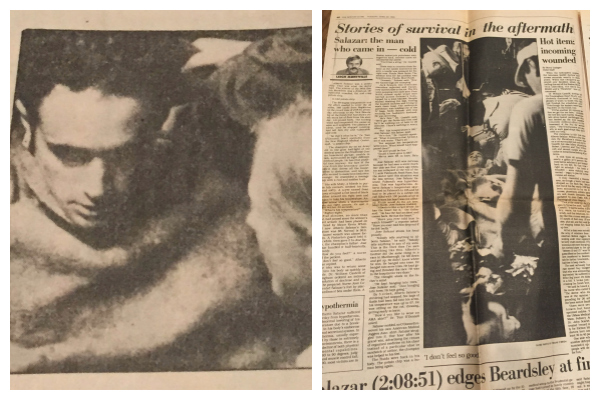
Salazar as “a potato chip: dried-out, dehydrated, unsalted, flat and crisp.”
I will never forget that day, it is etched in my memory in spite of the fact I wasn’t intentional about trying to remember every detail. I was very depressed when I returned home after our trip. I was disappointed in my personal performance, my youth had been no match for this historical event. It was difficult for me to figure out where to go next with my running. I had only been competing in running for a couple of years and had already done so well. I had already done the race most runners aspire to for many years and never achieve. What could top that? And then I read there would be a women’s marathon added to the Olympics in 1984. And the qualifying time for the Women’s Marathon Olympic Trials? 2:51:16. Perfect. Surely I could take 14 minutes off my marathon time within the year. I began looking for a coach…
The next time I would be back to Boston, for any reason, would be in 2013, when I “accidently” qualified again. But that’s a story for another time.
Jacquie Lemon Winters
Dallas, Texas
